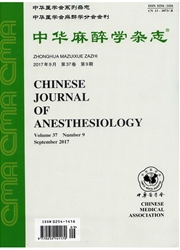

 中文摘要:
中文摘要:
目的探讨COMTval158met基因多态性对患者术前焦虑和疼痛敏感性的影响。方法择期手术患者284例,性别不限,年龄20~50岁,体重指数在正常范围,ASA分级Ⅰ或Ⅱ级;另取健康志愿者28名,年龄18。25岁,体重指数在正常范围。采用苯酚.氯仿萃取法提取DNA。采用聚合酶链式反应.限制性片段长度多态性法进行COMTval158met基因多态性检测。根据患者和健康志愿者基因型分组:野生型纯合子组(G/G组)、突变型杂合子组(G/A组)和突变型纯合子组(A/A组)。手术或试验前1d进行焦虑状态评分(SAI评分)和焦虑特质评分(TAI评分);患者或健康志愿者入室后平静10min,采用电刺激仪测定痛阈与耐痛阈。结果患者G/G组132例,G/A组110例,A/A组42例。健康志愿者G/G组12名,G/A组11名,A/A组5名。COMTval158met等位基因A突变频率为34.5%。健康志愿者3个基因组痛阈、耐痛阈、sAI评分和TAI评分比较差异无统计学意义(P〉0.05);与G/G组比较,患者A/A组痛阈、耐痛阈降低,SAI评分和TAI评分升高(P〈0.05),G/A组上述指标差异无统计学意义(P〉0.05);与健康志愿者比较,患者G/G组和G/A组SAI评分升高,A/A组痛阈、耐痛阈降低,SAI评分升高(P〈0.05)。患者COMTval158met等位基因A与耐痛阈、痛阈呈负相关,与术前SAI评分呈正相关(P〈0.05)。结论COMTval158met基因多态性与患者术前焦虑程度显著相关,以致引起患者疼痛敏感性增强。
 英文摘要:
英文摘要:
Objective To investigate the effects of catechol-O-methyltransferase (COMT)val158met ge- netic polymorphism on preoperative anxiety and pain sensitivity in patients. Methods Two hundred and eighty-four ASA Ⅰ or Ⅱ patients, aged 20-50 yr, with the body mass index within the normal range, Undergoing elective op- eration and another 28 healthy Volunteers, aged 18-25 yr, with the body mass index within the normal range, were enrolled in this study. Blood samples were taken from the peripheral vein for DNA extraction and COMTval158met genotyping using phenol chloroform extracting method and polymerase chain reaction-restriction fragment length polymorphism, respectively. The patients and healthy volunteers were assigned into 3 groups according to their genotypes: wild-type homozygotes (gro.up G/G), mutation hetorozygote (group G/A) and mutation homozygote group (group A/A). Anxiety was measured with State-Trait Anxiety Inventory (SAI/TAI) 1 day before operation or test. The pain threshold (PT) and pain tolerance threshold (PIT) in the participating subjects were measured by electric stimulation using a stimulator 10 min after admission to the operating room. Results There were 132 G/G, 110 G/A and 42 A/A among 284 patients, while 12 G/G, 11 G/A and 5 A/A among 28 healthy volunteers. The COMTval158met A allele frequency was 34.5%. There was no significant difference in the PT, PIT, SAI scoresand TAI scores between the three groups of healthy volunteers (P 〉 0.05). Compared with G/G group, the PT and PTT were significantly decreased and SAI and TAI scores were increased in group A/A of patients (P 〈 0.05). Compared with healthy volunteers, SAI scores were significantly increased in G/G and G/A groups of patients, and the PT and PTT were decreased and SAI scores were significantly increased in A/A group of patients ( P 〈 0.05). The COMTval158met A allele was negatively correlated with the PT and PTT and positively correlated with SAI scores in patients ( P 〈 0.05)
 同期刊论文项目
同期刊论文项目
 同项目期刊论文
同项目期刊论文
 Association of human micro-opioid receptor gene polymorphism A118G with fentanyl analgesia consumpti
Association of human micro-opioid receptor gene polymorphism A118G with fentanyl analgesia consumpti Influence of CYP3A5*3 polymorphism and interaction between CYP3A5*3 and CYP3A4*1G polymorphisms on p
Influence of CYP3A5*3 polymorphism and interaction between CYP3A5*3 and CYP3A4*1G polymorphisms on p Association of human mu-opiod receptor gene polymorphism A118G with fentanyl analgesia consumption i
Association of human mu-opiod receptor gene polymorphism A118G with fentanyl analgesia consumption i Study of the OPRM1 A118G associated genetic polymorphism with Postoperative Nausea and Vomiting indu
Study of the OPRM1 A118G associated genetic polymorphism with Postoperative Nausea and Vomiting indu CYP3A4 * 1G Genetic Polymorphism Influences Metabolism of Fentanyl in Human Liver Microsomes in Chin
CYP3A4 * 1G Genetic Polymorphism Influences Metabolism of Fentanyl in Human Liver Microsomes in Chin CYP3A4*1G genetic polymorphism influences CYP3A activity and response to fentanyl in Chinese gynecol
CYP3A4*1G genetic polymorphism influences CYP3A activity and response to fentanyl in Chinese gynecol 期刊信息
期刊信息
